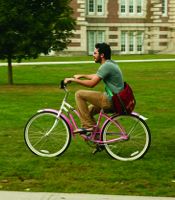President's Page: A Class Act
As I’m walking across the street from the President’s House to my office in Main Building, chances are I’ll see a student or two whizzing by on distinctive pink bicycles, headed for class. These bikes are part of a fleet of 30 that the class of 2009 presented to Vassar as its Sophomore Class Gift. Students can enroll in our Shared Bike Program for a $10 fee and receive a key that will unlock any of the pink bikes. If you’re in a hurry to get across campus and you have a key, you just find a bike, zip to class, lock the bike, and leave it for the next student in the program to use.
This simple but creative idea was a hit from the moment it was introduced on campus this fall, and it’s just one example of how a “green” consciousness is permeating life at Vassar these days. (What could be more fuel-efficient and environmentally friendly than traveling by bike?) What’s so interesting to me — and so heartening — is how much of the impetus for this consciousness around sustainability has come from the students. When I was in college in the ’70s, a great deal of student energy was devoted to political activism. Today, in addition to civic engagement I see very much a commitment to green activism.
It’s also squarely in the Vassar tradition. Think of Ellen Swallow Richards, class of 1870, who became the nation’s pre-eminent scientist of the study of water and made important contributions in the area of water sanitation; or Elizabeth Cushman Titus Putnam ’55, who founded the Student Conservation Association based on an idea she developed in her senior thesis at Vassar. This organization, which celebrated its 50th anniversary last year, has more than 40,000 alumni and offers high school, college, and graduate students hands-on environmental opportunities at more than 250 natural resource sites each year.
The Vassar curriculum, too, has long reflected a concern for these issues. The word “ecology” might seem to have intruded upon the world’s consciousness suddenly around the time I was in college; but here at Vassar, Edith Adelaide Roberts, professor of plant science, was popularizing the term half a century earlier. Science, Technology and Society is one of our oldest multidisciplinary majors; Environmental Studies, which grew out of an already well-established Environmental Science major, is one of our newest and most popular. This past semester, students could take courses in “The Ecology of the Mid-Hudson Valley” and in “Energy Sources and Policies,” to name just two; offerings for next term include “The History of Climate Change,” and “Environmental and Natural Resource Economics.”

In addition, as we contemplate a new science center, the architect we have engaged, Polshek Partnership Architects, brings a sustainability expertise to the project. And speaking of our buildings, perhaps the greenest thing of all that we do is maintain and renovate these wonderful structures rather than tearing them down, thus sustaining our architectural heritage while conserving resources at the same time.
Another wonderful aspect of all this green activism is the way that it brings students and other members of the Vassar community together to work on a worthy cause. For example, an alumnus, Paul Lehman of the class of 1986, gave a challenge gift to the class of ’09’s project, helping to spur the students on in their own successful fund raising for their class gift.
At the end of the day, I’m going to turn off the compact fluorescent lights in my office and, still dodging the occasional pink bike, head home to the President’s House, which has also been refitted with compact fluorescent light (CFL) bulbs, is kept spotless (well, give or take our dog, Nelly) with green cleaning products, and where everything that can be recycled is!

